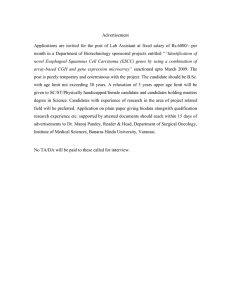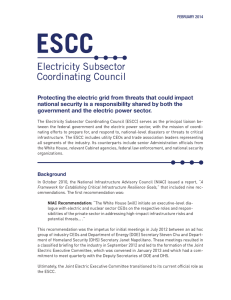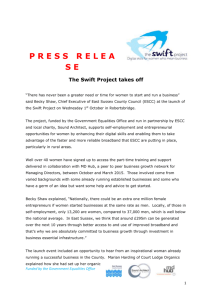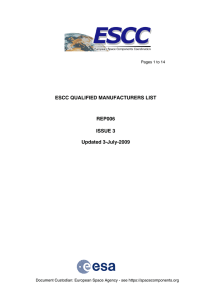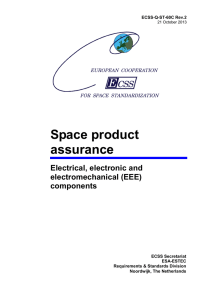Protecting the electric grid from threats that could impact
advertisement
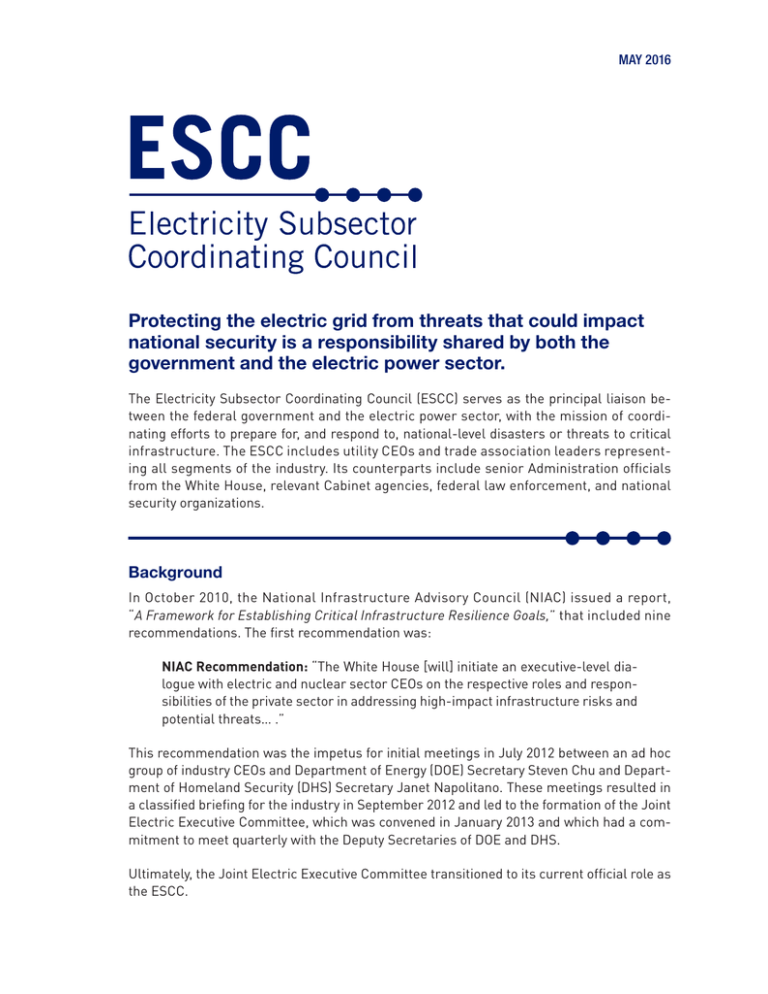
MAY 2016 Protecting the electric grid from threats that could impact national security is a responsibility shared by both the government and the electric power sector. The Electricity Subsector Coordinating Council (ESCC) serves as the principal liaison between the federal government and the electric power sector, with the mission of coordinating efforts to prepare for, and respond to, national-level disasters or threats to critical infrastructure. The ESCC includes utility CEOs and trade association leaders representing all segments of the industry. Its counterparts include senior Administration officials from the White House, relevant Cabinet agencies, federal law enforcement, and national security organizations. Background In October 2010, the National Infrastructure Advisory Council (NIAC) issued a report, “A Framework for Establishing Critical Infrastructure Resilience Goals,” that included nine recommendations. The first recommendation was: NIAC Recommendation: “The White House [will] initiate an executive-level dialogue with electric and nuclear sector CEOs on the respective roles and responsibilities of the private sector in addressing high-impact infrastructure risks and potential threats… .” This recommendation was the impetus for initial meetings in July 2012 between an ad hoc group of industry CEOs and Department of Energy (DOE) Secretary Steven Chu and Department of Homeland Security (DHS) Secretary Janet Napolitano. These meetings resulted in a classified briefing for the industry in September 2012 and led to the formation of the Joint Electric Executive Committee, which was convened in January 2013 and which had a commitment to meet quarterly with the Deputy Secretaries of DOE and DHS. Ultimately, the Joint Electric Executive Committee transitioned to its current official role as the ESCC. ESCC Areas of Focus Industry and government leaders have agreed to focus on four main areas that improve the security posture of the industry and the nation. To support the deployment of tools, improve the flow of threat information, prepare for incidents, and work closely with other interdependent infrastructure sectors, the ESCC has organized into committees with the following missions: Industry-Government Coordination: Unify industry and government efforts to plan and prepare coordinated responses to incidents affecting grid security. Leveraging Infrastructure / Research & Development: Guide infrastructure investments and R&D to encourage the more efficient deployment of critical infrastructure protection tools and technologies. Threat Information Sharing & Processes: Improve and institutionalize the flow of, and access to, threat information among public- and private-sector stakeholders. Cross-Sector Coordination: Develop strong partnerships among electricity and other critical infrastructure sectors (communications, transportation, financial services, water, and downstream gas) to plan and respond to major incidents, better understand and protect our mutual dependencies, and share information effectively. Senior Executive Working Group To support the mission of the ESCC, a Senior Executive Working Group (SEWG) of Chief Operating Officers, Chief Information Officers, and other senior executives who have relevant expertise in the electric power sector has been convened. The SEWG meets by phone on a monthly basis and creates ad hoc “sub-teams” to accomplish the goals identified by the CEOs and Deputy Secretaries. In parallel to this effort, the government also is organizing around these goals with a commitment to align government and industry efforts. ESCC OFFICIAL ROSTER May 2016 Leadership (3) Tom Fanning, Southern Company (co-chair) Kevin Wailes, Lincoln Electric System (co-chair) Duane Highley, Arkansas Electric Cooperative (co-chair) Steering Committee (9) Sue Kelly, American Public Power Association Sergio Marchi, Canadian Electricity Association Tom Kuhn, Edison Electric Institute John Shelk, Electric Power Supply Association Andrew Ott, PJM (representing the ISO/RTO Council) Mike Wallace, National Infrastructure Advisory Council Jeffrey Connor, National Rural Electric Cooperative Association Gerry Cauley, North American Electric Reliability Corporation Marv Fertel, Nuclear Energy Institute Asset Owners (19: 12 investor-owned utilities; 3 electric cooperatives; 3 municipal utilities) Nick Akins, American Electric Power Jim Torgerson, Avangrid Scott Miller, City Utilities of Springfield John McAvoy, Consolidated Edison Tom Farrell, Dominion Lynn Good, Duke Energy Ted Craver, Edison International Gianna Manes, ENMAX Corporation Chris Crane, Exelon Corporation Greg Ford, Georgia System Operations Corporation David Saggau, Great River Energy Connie Lau, Hawaiian Electric Industries William Fehrman, MidAmerican Energy Co. John Bilda, Norwich Public Utilities Jack Reasor, Old Dominion Electric Cooperative Tony Earley, PG&E Corporation Bill Spence, PPL Corporation Lonnie Carter, Santee Cooper Ben Fowke, Xcel Energy ESCC Coordination Responsibilities Coordination among senior government and industry executives helps to ensure an effective response, appropriate prioritization and allocation of resources, and support for deviation from standard procedures during an incident. Industry-Government Coordination ESCC Organizational Structure Energy Sector-Specific Agency Organizational Structure
